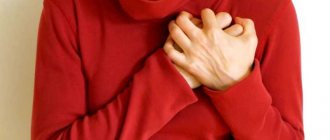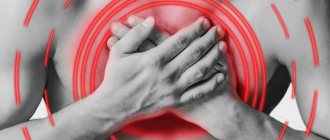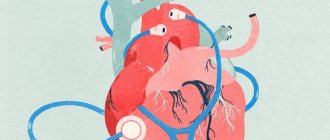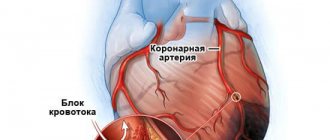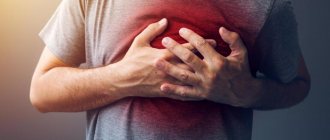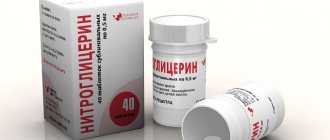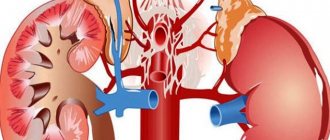Causes of burning behind the sternum and additional symptoms
A burning sensation in the heart area appears not only with cardiovascular pathology. Such unpleasant symptoms are accompanied by diseases of the spine, pathologies of the endocrine system, nervous disorders, and gastrointestinal problems.
The situation forces me to seek help from a cardiologist. After a preliminary examination, the patient is recommended to visit an endocrinologist, therapist or neurologist. The most dangerous disease accompanied by similar symptoms is a heart attack. But in the chest there are respiratory organs, blood vessels, and nerve bundles.
Pain syndromes and burning are accompanied by other pathologies:
- angina pectoris;
- pericarditis;
- cardioneurosis;
- aortic aneurysm;
- pneumonia;
- dystonia of the vegetative-vascular system;
- pathology of the nervous system or musculoskeletal system;
- failure in the hormonal system;
- gastrointestinal diseases.
Similar symptoms appear in women during PMS, in people after heavy emotional and physical stress. A specialist doctor will be able to identify the cause and prescribe appropriate treatment after a thorough diagnostic examination.
Angina pectoris and a feeling of itching in the heart area - how comparable are they?
Angina pectoris or angina pectoris, as this disease is also called, is associated with impaired blood supply to the heart muscle and is manifested by pain in the sternum, which can radiate to almost all anatomical areas. In principle, itching may also occur, but this is more of a reflex reaction associated with stimulation of the nervous system. Or as the initial stage of clinical manifestations.
The most important thing in this situation is not to try to establish any cause-and-effect relationship between angina pectoris (regardless of the types of this disease) and itching of the skin in the sternum area. In other words, such symptoms cannot be excluded, but itching in the chest area should not be called a typical picture of angina either. Maybe, maybe not.
To eliminate the symptom, if it does appear, it would be advisable to use nitroglycerin. And also sedatives:
- valocordin in drops;
- barked;
- validol.
Burning sensation in the cardiac region in diseases of the cardiovascular system
Sharp pain in the heart area always causes panic in patients. It is difficult for a person to take a full breath, and fear of death appears. It is worth excluding all fears, since such a condition does not always pose a threat to life if the pain is temporary.
Usually a number of sedatives are prescribed to help get rid of unpleasant sensations. But a prolonged burning sensation in the heart area is a dangerous symptom that requires immediate help.
Angina pectoris
A burning sensation in the heart area with angina pectoris (angina pectoris) appears in the left side of the chest after heavy physical and psycho-emotional stress.
The attack usually lasts no more than an hour.
If this is excluded, the symptoms often disappear quickly. Angina pectoris is not a separate disease. This is a syndrome accompanying pathologies of the cardiovascular system.
Pericarditis
Inflammation of the heart membrane. It occurs against the background of rheumatism or as a consequence after a heart attack, diseases of internal organs, or infectious pathologies. It occurs in acute or chronic form. In addition to pain, shortness of breath, dry cough, malaise, and chills may appear.
A characteristic symptom is increased pain when trying to take a deep breath or swallowing. The pain decreases when the patient changes body position. With timely treatment, the prognosis is positive.
Cardioneurosis
Cardiac pathology that occurs against the background of emotional and physical stress. The patient complains of pain, burning in the chest, in the area of the heart, which occurs periodically. An attack can last from several minutes to several hours. The frequency of symptoms varies. Sometimes it can appear several times throughout the day. Other patients complain of symptoms that occur rarely.
In addition to the characteristic pain, other symptoms are present:
- anxiety;
- panic state;
- obsessive thoughts about a terrible pathology;
- chills;
- rapid breathing;
- dizziness or headaches;
- increased sweating;
- fatigue, drowsiness;
- insomnia;
- fainting.
Such conditions appear after nervous breakdowns or overexertion. Symptoms quickly resolve after taking or administering sedatives. Hospitalization is indicated in rare cases.
Heart attack
The most common pathology caused by acute disruption of the blood supply to the heart. This leads to the death of part of the affected heart muscles, against which necrosis develops. Death of cardiac cells occurs within 20 minutes. after the onset of the attack.
It is important to recognize the symptoms in a timely manner to avoid serious consequences:
- A burning sensation in the heart area, turning into a sharp pain that radiates under the shoulder blade and into the left arm.
- A feeling of fear and discomfort appears.
- The attack is accompanied by chills or increased sweating.
- Nitroglycerin taken does not help relieve pain.
- The heart rate decreases or increases.
- Blood pressure rises.
A burning sensation in the heart area can cause a heart attack.
To recognize it and provide timely assistance, it is important to know all the symptoms. The disease has the highest mortality rate. It is important to recognize it in time by its characteristic warning signs in order to provide the person with timely help. The symptoms presented in the tables should be a cause for concern. It is better to call an ambulance or go to the nearest medical facility.
| Symptoms | Clinical picture |
| Anginal pain | A burning sensation and coldness appear in the area of the heart and lungs. Pain sensations radiate to the shoulder blade, left arm, neck, back. The condition is accompanied by pale skin and cold sweat. The patient feels restless and nervous. |
| Abdominal pain | Pain and burning in the chest appear simultaneously with nausea, which persists after bouts of vomiting. Along with these symptoms, heartburn and unpleasant belching may appear, and the pain intensifies when palpating the chest. |
| Atypical pain | Pain that appears in places that are not typical for the heart. In the lower jaw, throat, fingers. |
| Asthmatic symptoms | Shortness of breath, lack of air. |
| Arrhythmic symptoms | Increased heart rate and pulse. |
Aortic aneurysm
A pathology that is more common in people of retirement age. The aorta is an artery that leaves the heart and passes through the entire body. An aneurysm is an expansion of one of the areas. If the walls of the aorta are weak, it can rupture and be fatal. The risk increases if the aneurysm is larger than 5 centimeters.
In many patients, the disease can develop over several years without showing characteristic symptoms. It depends on which part of the aorta is affected. Most often, throbbing pain appears in those parts of the body where the aneurysm appeared.
The disease often occurs as a consequence of atherosclerosis, in which the walls of the aorta become clogged with cholesterol plaques and fibrous tissue appears.
Doctors identify several facts that provoke the disease:
- bad habits;
- unhealthy diet, eating foods high in cholesterol;
- age-related changes in the body;
- hypertension;
- sedentary lifestyle;
- obesity.
If a rupture occurs, emergency surgery is necessary, otherwise death is possible.
Vegetovascular dystonia
This pathology is not a disease and has no classification. It is considered a consequence of other diseases.
Therefore, a wide variety of symptoms may occur:
- sense of anxiety;
- dyspnea;
- pressure surges;
- cardiopalmus;
- feeling of a lump in the throat;
- constipation or diarrhea;
- discomfort, bloating in the abdomen;
- heartburn;
- dizziness;
- heat.
Symptoms may appear individually or simultaneously. If the attending physician diagnoses VSD, this means that a more thorough diagnosis is required, which will reveal the true cause of the unfavorable condition.
Symptoms
If tingling in the heart is a clinical manifestation of a cardiogenic disease, then the following symptoms will be present:
- acute pain on the left, which manifests itself periodically at rest or during certain actions (physical activity, emotions, physical activity);
- shortness of breath, frequent and shallow breathing; when trying to take a deep breath, the tingling sensation may intensify;
- rapid pulse;
- dizziness;
- high blood pressure;
- increased sweating, in some cases especially intense at night;
- fatigue, decreased performance even after a long rest.
The nature of the duration of pain will depend on the underlying factor. So, with angina pectoris, tingling in the heart and pain are observed from 5 to 30 minutes, can radiate to the left arm, are easily relieved by an attack, and occur only after physical exertion or emotional shock.
An identical nature of tingling and pain in the heart will be observed with myocardial infarction, however, the distinguishing feature will be that with such a pathology, the pain is not eliminated by nitroglycerin, and a panic state, fear of death, and severe shortness of breath are added to the general clinical picture.
Regardless of the nature of the manifestation of this clinical sign, you should immediately seek medical help. In some diseases, delay threatens not with complications, but with death.
With excessive physical exertion, the manifestation of such a symptom may be due to a lack of oxygen. This is due to the fact that the vessels simply cannot cope with physical activity. That is why this symptom often manifests itself in those who, without the proper level of physical fitness, sharply load the body during training.
The cause of tingling in the heart may be a gastroenterological disease. In this case, the symptom will be reflective in nature, and the additional clinical picture will be characterized as follows:
- abdominal pain, which can radiate to the chest area and back;
- heartburn, belching of sour or air, depending on the provoking factor;
- unstable stool;
- nausea and vomiting, which most often occurs after eating fatty foods that are difficult for the affected intestines;
- unpleasant taste in the mouth;
- a foul, pungent odor may emanate from the mouth;
- weight loss;
- deterioration or, on the contrary, increase in appetite;
- general malaise, weakness, decreased performance.
This clinical picture is typical for many gastroenterological diseases, so self-medication in the presence of such symptoms is strongly not recommended. All therapeutic measures should be carried out only after an accurate diagnosis.
Tingling in the area of the heart may be due to intercostal neuralgia, which will be accompanied by a typical clinical picture for this disease:
- spontaneously occurring pain and tingling in the heart, which can persist for quite a long time;
- at the site of localization of the pathological process, swelling of the skin may be observed;
- when you try to change your body position, cough or take a deep breath, the pain and tingling become more intense.
Intercostal neuralgia
A similar clinical picture may be present with osteochondrosis, but the following additions take place:
- limitation, stiffness of movements;
- muscle pain;
- feeling of coldness in the fingers;
- muscle weakness.
In case of pathologies of the lung or both organs, tingling in the heart can be supplemented by the following clinical manifestations:
- shortness of breath that does not go away even with complete rest;
- pain in the chest area, feeling of tightness, heaviness;
- increased sweating;
- labored breathing;
- tachycardia;
- dizziness;
- cyanosis of the skin;
- nausea, vomiting that does not bring relief;
- abdominal ascites with pulmonary hypertension.
Tingling in the heart is no exception as a sign of infectious diseases. In such clinical cases, the above symptom will be supplemented by the following symptom complex:
- signs of general intoxication of the body;
- low-grade or elevated body temperature;
- rashes on the body;
- headache;
- symptoms of ARVI - sore and sore throat, runny nose, weakness, drowsiness;
- dysfunction of the gastrointestinal tract.
For any symptoms, you need to seek qualified help, that is, a doctor. Only a doctor can determine the true cause of this symptom and prescribe effective treatment.
Nervous system diseases
Symptoms characteristic of diseases of the cardiovascular system appear with changes in the central and peripheral nervous system. This is often diagnosed as intercostal neuralgia. Acute pain appears in the heart area. On palpation, the pain increases, muscle twitching or numbness is noticeable.
The cause of pain that appears in the chest and radiates to the shoulder blade can be:
- hypothermia;
- great physical activity;
- intoxication after taking certain drugs;
- toxic, infectious infections (botulism).
Damage to nerve fibers can occur against the background of various tumors. The disease also appears after spinal injuries. In this case, the syndrome intensifies when coughing, during a sudden change in body position.
Why does the heart tingle?
Below is a basic list of reasons that can cause tingling in the heart area.
Heart pathologies
Myocarditis
Myocarditis is an inflammatory process that affects the heart muscle. It appears as a result of the negative effects of drugs or toxins that cause damage to the cellular structures of the myocardium. Very often it has an infectious etiology. Such lesions can be provoked by measles, mononucleosis, influenza, hepatitis viruses, as well as HIV infection.
The disease has acute, moderately acute and chronic forms. Unpleasant sensations are usually long-lasting, do not depend on physical activity and have a stabbing or pressing character. Other symptoms are:
- dyspnea;
- slight tingling in the heart area;
- tachycardia;
- interruptions in the functioning of the heart muscle;
- dizziness;
- fainting.
The prognosis of myocarditis depends on the specific situation. Almost 30% of patients experience complete recovery. Death occurs in approximately 4% of cases. There is a high risk of developing subsequent complications, in particular chronic heart failure.
Mitral valve prolapse
A congenital anatomical abnormality that results in incomplete closure of the valve during heart contractions. Diagnosed in 20% of healthy people. This process may be accompanied by attacks of arrhythmia, shortness of breath, weakness, swelling, pain, which manifests itself during physical activity.
Typically, this anatomical feature does not require radical therapeutic measures. Surgical intervention is carried out in rare, exceptional situations, with a severe deterioration in health.
In other cases, preventive measures are indicated, which boil down to dosing physical activity and protection against infections.
Coronary heart disease (CHD)
If there is tingling in the area of the heart, the cause is sometimes damage to the heart muscle caused by insufficient blood supply to the myocardium due to spasm of the coronary vessels. IHD is characterized by a feeling of discomfort behind the sternum, sensations of lack of air, difficulty breathing, rapid heartbeat (up to 300 beats per minute) and associated circulatory arrest.
The causes of its occurrence may be excess weight, hypertension, atherosclerosis, improper work and rest schedule. In the absence of adequate treatment, the disease can cause serious complications, including myocardial infarction and sudden cardiac arrest. IHD is the most common cause of death among cardiovascular pathologies.
Among other ailments associated with the heart muscle, stabbing pain causes:
- angina pectoris;
- pericarditis;
- heart disease;
- myocardial infarction;
- cardiomyopathy.
Not cardiac pathologies
Neurocirculatory dystonia (cardiovascular neurosis).
A complex disorder manifested against the background of organic lesions of the vegetative-vascular and nervous systems. Provoking factors include acute or chronic infections, psychological trauma, various intoxications, excessive physical activity, and hormonal disorders. The main symptoms are:
- weakness;
- fast fatiguability;
- irritability;
- memory impairment;
- heartbeat;
- dyspnea;
- arrhythmia;
- headache;
- muscle weakness;
- arterial hypertension;
- sleep disorder
Dystonia has a benign course. There are no life-threatening disturbances in the functioning of the cardiovascular system. The main measure to prevent it is the promotion of a healthy lifestyle.
Lung diseases
Lung problems are among the most common pathological processes that cause a tingling sensation in the heart area. Among them are pulmonary hypertension, pleurisy, tracheitis, bronchitis, pulmonary infarction, and tumors. The peculiarity of lung tissue is its weak innervation. Therefore, the discomfort is not marked by severe pain in the areas where the lesions are located.
Pain signals are received by areas of the nervous system located in close proximity to the heart muscle. This leads to the fact that a person begins to mistakenly perceive pain in the lungs as cardiac pain. In such situations, enhanced diagnostic procedures aimed at identifying a potential pathological focus are indicated.
Osteochondrosis
Stitching pain with osteochondrosis usually appears if the cervical spine is affected. This is due to compression of the arteries and nerve fibers, which most often occurs during prolonged periods of immobility, after or during sleep. Discomfort increases with coughing or sudden movements.
If you feel a tingling sensation in the heart area, the causes may also be hidden in the following ailments or phenomena:
- stomach ulcer;
- diaphragmatic hernia;
- diseases of the musculoskeletal system;
- chronic stress;
- increased physical activity;
- use of certain medications.
Endocrine disorders
Pain is the body’s signal about a problem. There are many diseases of the endocrine system that are accompanied by chest pain. They are not limited to thyroid diseases.
Characteristic symptoms occur with pathology of the pancreas, adrenal glands, and pituitary gland.
The functioning of the entire body depends on the state of the endocrine system. Often the diseases are accompanied by increased heartbeat, fatigue and chest pain that resembles heart pain.
Angina pectoris
Heart pain with angina pectoris can be in the form of a burning sensation in the chest. “It burns with fire, it bakes” can often be heard from patients. Often with angina, the burning sensation spreads to the area of the shoulder blade and left arm. The distinctive signs of the disease are:
- pain usually occurs during physical activity,
- decreases after taking nitroglycerin. Patients with angina pectoris experience relief from nitroglycerin. Once you take one or two nitroglycerin tablets, the pain goes away.
Spine pathologies
Throughout life, the spine is subject to heavy loads. Maintaining its elasticity and flexibility is difficult, especially in older age. Each disease is characterized by certain symptoms. Chest pain is one of the characteristic signs of pathologies associated with the main human trunk.
Osteochondrosis
Intervertebral disc disease. The localization of pain depends on where in the spine the pathology occurs. The most common manifestation is back pain that radiates to the chest area. Such pain appears especially often if osteochondrosis appears in the thoracic or cervical region.
In addition to pain, symptoms reminiscent of cardiovascular diseases occur:
- dizziness;
- loss of consciousness;
- headache;
- tinnitus;
- lump in throat;
- fainting;
- shortness of breath;
- fatigue;
- excitability.
Pinched nerve
The pathology occurs when the nerve roots extending from the main canal of the spinal cord are compressed. This is always accompanied by severe pain. The location of the appearance depends on which part of the spine the pinching occurs. Most often the lumbar, thoracic, and cervical regions are affected. When pinched in the cervical region, a sharp, shooting pain appears, radiating to the shoulder blade and chest.
Symptoms intensify when trying to turn or bend the head. Therefore, patients complain of heart pain.
A distinctive characteristic of such pains is that they intensify during a night's rest, when coughing, laughing, while sneezing, or with severe excitement.
What to do if it itches a lot in the area of the heart: is this symptom dangerous?
Everyone knows very well how dangerous pain in the heart can be and what consequences it can lead to - cardiovascular diseases are the most significant cause of mortality in the world, in percentage terms.
However, this is a sharp and paroxysmal pain, and now we are talking about itching of the skin in the sternum area - this is a completely different complaint, which has a different origin and is associated with other problems.
Before looking for the answer to the question “why it itches in the heart area,” it is necessary to dispel
one very significant stereotype, but at the same time false - many people believe that the projection zone of the heart is located somewhere in the area of the left breast, and demonstratively grab it with their right hand, indicating that their heart has “grabbed” . In fact, everything is completely different - the area of projection of the heart should be considered the anatomical area corresponding to the sternum. That is, the article will examine the localization of unpleasant sensations in this particular place.
It is necessary to pay attention to the following:
- the cause of itching in the heart area is of fundamental importance;
- The effectiveness of therapy depends on how much it affects the immediate cause of pain.
So, let's look at the causes of itching in the heart area and approaches to eliminating this symptom.
Diseases of the gastrointestinal tract
A burning sensation in the heart area and pain are possible with various gastrointestinal pathologies. In this case, accompanying symptoms are characteristic: heartburn, belching with an unpleasant odor, vomiting, diarrhea.
This situation usually accompanies the following diseases:
- gastritis;
- ulcers;
- pancreatitis;
- esophagitis;
- colitis.
With these pathologies, pain will appear on the left or right side of the chest immediately or a few hours after eating. Usually these are fried, fatty, spicy dishes. In such situations, the sphincter weakens, which leads to acid entering the esophageal mucosa and the appearance of unpleasant symptoms.
Causes
In most cases, burning heart pain occurs due to compression in the chest and a feeling of lack of oxygen. The patient may experience darkening of the eyes, fever, irregular heartbeat, headache and other symptoms. There are many reasons for the formation of such a problem, and some of them appeared due to poor lifestyle choices:
- lack of sleep;
- poor or unbalanced diet;
- insufficient or, conversely, excessive physical activity during the day;
- bad habits and their abuse;
- frequent stress and nervous disorders.
These factors influence the development of pathologies and malfunctions in the human body, which lead to discomfort in the chest area. But it is worth understanding that the source of pain is not always the heart, because it can radiate to other organs, so identifying the true source is not always easy.
If we talk about reasons related to health status, then each of them should be considered in more detail.
Spine
A burning sensation in the heart area and sharp pain may appear due to the progression of osteochondrosis, which is characterized by displacement of the intervertebral discs or deformation of the vertebrae, which leads to pinched nerves.
People suffering from this disease experience numbness in their hands and signs of paresthesia. By the evening, all these problems usually worsen, but by the morning it becomes easier. The pain is especially severe during exercise and movement.
Heart failure
A burning sensation can be felt in the following pathologies:
- myocardial infarction;
- vegetative-vascular dystonia;
- angina pectoris.
With the first pathology, in addition to burning sensations, the following symptoms appear:
- heart rhythm disturbance;
- numbness of the lower jaw and limbs;
- increased body temperature and cold sweat;
- labored breathing;
- fainting or dizziness.
When it comes to VSD, it usually develops after a malfunction in the autonomic nervous system. Attacks may occur due to constant overwork, stress, colds and other factors. All these problems may be accompanied by a number of the following symptoms:
- aching and stabbing pain chest pain;
- general weakness and slight dizziness;
- tachycardia;
- panic attack;
- trembling in the body;
- increased sweating;
- surges in blood pressure.
There is usually no severe pain, but a slight tingling sensation may appear in the chest.
If a patient experiences angina pectoris, then it is characterized by dull pain in the left side of the heart muscle and heaviness. All these signs can radiate to the scapula and left arm. The cause of such an attack is experienced stress or physical overload.
Gastrointestinal tract
Burning sensations may even indicate the development of stomach problems. Most often, the whole problem lies in a diaphragmatic hernia. When bending over and coughing, the patient feels an increase in discomfort, which is complemented by nausea, heartburn, vomiting, belching and breathing problems. After each meal, tachycardia and bloating may occur.
Hormonal balance
This problem usually occurs in women during menopause, and is accompanied by a number of unpleasant sensations:
- burning in the heart muscle;
- tachycardia;
- changes in psycho-emotional background;
- problems with the digestive system;
- osteoporosis;
- blood pressure surges;
- metabolic syndrome.
Typically, a burning sensation occurs during “hot flashes,” which are characterized by a hot wave running throughout the body.
Hormonal imbalance
Hormonal imbalance can occur in both female and male bodies. The situation is dangerous because it entails not only a deterioration in well-being, but also disruptions in the functioning of many systems and organs. The human body is subject to many changes throughout life, which leads to disruption of the hormonal system.
Diagnosis of the situation is complicated by the fact that symptoms may resemble heart disease:
- chest pain;
- arrhythmia;
- nervousness;
- headache;
- pressure surges;
- fainting.
The situation is dangerous because, in the absence of proper treatment, it can provoke the appearance of hormonal tachycardia.
The functionality of the myocardium directly depends on the production of some hormones.
- Adrenaline produced by the adrenal glands helps to strengthen and normalize the activity of the heart.
- Hormones containing iodine are produced by the thyroid gland and have a strengthening effect on the heart muscle.
- The pancreas produces the hormone glucagon, which is responsible for the number of heart contractions.
Any disturbances in the hormonal system lead to pathological changes in the myocardium. There is a rapid heartbeat, burning and pain in the heart area, and lack of air.
Shingles
A disease caused by the varicella-zoster virus. The same virus provokes chickenpox, which is familiar to many from childhood memories. But not everyone knows that after suffering from chickenpox, the virus can remain in the body. When provoking factors appear, the virus can become more active, after which shingles appears.
The disease is easy to treat, after which the body develops strong immunity. A characteristic symptom of the pathology is burning and severe pain in the affected area. They get worse at night and people may confuse this with cardiovascular disease.
How to find the source
Determining the source of a burning sensation in the heart area consists of several stages. Diagnostic criteria take into account concomitant diseases, characteristics of pain and other symptoms, and the effect of medications.
If the cause of the pain is associated with cardiac pathology, there is a history of coronary heart disease or hypertension (persistent increase in blood pressure). The pain syndrome during a heart attack is characterized by high intensity, compression in the chest, irradiation to the left shoulder, scapula and lower jaw. An attack of angina pectoris is accompanied by a lack of air and acute stabbing pain.
Infectious pathologies of the lungs are characterized by fever and symptoms of respiratory failure (rapid shallow breathing, participation of additional muscles). The pain syndrome with severe exudative pleurisy and rib fractures intensifies during inspiration. Diseases of the gastrointestinal tract are distinguished by the following symptoms: defecation disorders, nausea and vomiting. Pain in acute cholecystitis is most often localized in the right hypochondrium with irradiation to the right shoulder and scapula.
An attack of vegetative-vascular dystonia is characterized by a variety of symptoms: from dizziness to increased heart rate and loss of consciousness. A burning pain in the heart area is possible as a manifestation of a psychosomatic disorder.
Plan of instrumental and laboratory examination:
- Measure the temperature - high values throughout the day indicate an infectious or acute inflammatory process (pneumonia, pleurisy).
- Blood pressure - dissecting aortic aneurysm occurs against the background of a hypertensive crisis (level of indicators - 210/120 mm Hg).
- Complete blood count - an increase in ESR and leukocytes indicates inflammation.
- Electrocardiography (ECG) - to determine changes in heart rhythm during a heart attack. Tachycardia (increased heart rate), bundle branch block, and atrial fibrillation are more often recorded.
- Chest X-ray - performed to exclude the diagnosis of pneumonia, pleurisy, rib fractures, osteochondrosis and changes in heart size (with effusion pericarditis).
- Ultrasound examination of the heart and blood vessels (echocardiography - EchoCG) - determines focal changes in the myocardium during infarction, rheumatic defects and myocarditis.
- Fibrogastroduodenoscopy is an endoscopic method for diagnosing diseases of the upper gastrointestinal tract. Used to detect gastric ulcers and esophageal pathologies.
- Ultrasound examination of the abdominal organs to exclude acute cholecystitis.
- Biochemical blood test - increased bilirubin indicates cholecystitis.
- Markers of myocardial necrosis (troponins I and T, CPK-MB) are used to diagnose the acute stage of a heart attack.
If, after all the studies, no organic pathology is found, and the patient continues to complain that he is in pain, the doctors write in the card “vegetative-vascular dystonia.” For information on how to act for a patient with such a “diagnosis,” see our video at the link below.
When should you call an ambulance?
Any discomfort, burning, pain in the heart area should not be ignored. This is how the body signals a possible health problem. Self-medication has never helped anyone properly.
Therefore, the reason for an emergency call to the brigade should be:
- sharp chest pain;
- convulsions appeared;
- pain in the back, lower back, stomach;
- headache accompanied by nausea, dizziness;
- at a tower temperature of 39 degrees, which cannot be lowered with the help of medications;
- all symptoms are present at the same time;
- The patient has noticeably impaired speech or coordination of movements.
Before the team arrives, it is necessary to ensure complete rest and access to fresh air.
Differences between heart pain and other pain
There are several types of pain that have delineation criteria:
- heart pain is not associated with body position, time of day, breathing;
- palpation of the heart area does not increase pain;
- The Nitroglycerin test is always positive, but analgesics do not work.
These are fairly reliable criteria, but you need to remember that there are exceptions to any rule. A reliable diagnosis is possible only with a complete clinical and laboratory examination.
Emergency measures for a heart attack
If there is a suspicion that a loved one has had a heart attack, you cannot remain without assistance until the ambulance arrives. There are a number of activities that should be done first and those that should not be done.
First aid for a patient with suspected heart attack:
- put to bed and ensure complete rest;
- give a capsule of nitroglycerin under the tongue, it is better not to give a second tablet;
- measure the pressure and if it is low, then nitroglycerin is contraindicated;
- if a person is not allergic to aspirin, you can offer him one tablet;
- Valocordin is useless for a heart attack, but it will help calm the nervous system.
You should not apply mustard plasters or heating pads to the heart area. If the condition is accompanied by attacks of suffocation, then heat will only aggravate the condition.
The most important thing in such a situation is the rapid arrival of an ambulance and hospitalization of the patient.
Drug treatment
To cope with stabbing sensations in the heart, the following medications are used:
- "Validol" - this remedy has a sedative effect. It is applied sublingually and dissolved until the tablet is completely dissolved. The patient's condition returns to normal within 5-15 minutes. It is especially useful to take the substance in a state of stress or when discomfort rarely occurs.
- "Corvalol" - the drug is produced in the form of tablets and alcohol tincture. The substance has a pronounced calming effect. The alcohol base calms the nerves. The disadvantage of the drug is considered to be a negative effect on the liver.
- “Valocordin” is produced in the form of an alcohol tincture, which promotes vasodilation. The number of drops taken should correspond to the patient's age.
- "Nitroglycerin" - this substance has a quick effect. It has calming properties and belongs to the category of effective antispasmodics. You should take the medicine if you suspect a heart attack. It also quickly relieves severe pain. However, it is recommended to use the product only in case of severe pain or on the recommendation of a doctor. The tablets are dissolved in the mouth until dissolved.
- "Cardiomagnyl" is an effective analgesic that helps provide first aid and relieve pain.
- Aspirin helps relieve pain. In a critical condition, the substance is combined with Analgin, while calling an ambulance.
- “Sedalgin”, “Spazmalgon”, “Ketanov” are effective analgesics that have a wide spectrum of action.
Diagnosis and differential diagnosis
In case of characteristic symptoms, the doctor performs a differential diagnosis to exclude diseases that have similar symptoms. In order for the diagnosis to be made accurately, the doctor must have a high professional level.
Such diagnostics are carried out in several stages:
- Symptoms corresponding to the suspected disease are determined.
- The exact characteristics of the identified symptom are determined.
- Differentiation. Using a special list to compare or exclude symptoms of a suspected disease.
- Analysis of the information received. If it is concluded that the symptoms do not correspond to the expected diagnosis, the disease is excluded.
- Making a final diagnosis.
Diagnosis is based on the characteristic signs noted in the patient:
- anamnesis;
- pressure measurement;
- identification of obvious symptoms (shortness of breath, swelling, physical condition);
- confirmation that the symptoms are associated with cardiac disorders and not with diseases of other organs;
- laboratory and instrumental examination;
- ECG;
- X-ray;
- echocardiography.
The attending physician determines how to carry out the diagnosis.
Clinical manifestations
If the heart tingles due to cardiac pathologies, the patient will experience symptoms:
- pain on the left, increasing under certain conditions (physical activity, physical activity);
- feeling of lack of air;
- “goosebumps” in the area of the heart;
- dyspnea;
- cardiopalmus;
- dizziness;
- semi-fainting state;
- increased blood pressure;
- decreased performance;
- fast fatiguability;
- increased sweating.
The duration of pain depends on the provoking factor. For example, with angina pectoris, a strong or mild tingling sensation in the heart area can last from 5 to 30 minutes. The pain often radiates to the left arm.
Important! The same sensations are observed during myocardial infarction. Panic attacks and fear of death are added to the clinical manifestations.
Gastroenterological symptoms include:
- abdominal pain radiating to the back, arm, chest;
- gastrointestinal disorder;
- belching, heartburn;
- unpleasant taste in the mouth;
- vomiting, nausea;
- loss of appetite;
- weight loss;
- general malaise.
Clinical manifestations are characteristic of many gastrointestinal diseases, so self-medication is not recommended.
Treatment methods for different types of pathology
Burning and pain in the chest is not a separate disease. This is a symptom that accompanies various diseases. There can be no clear treatment. The treatment method is prescribed by the attending physician after diagnosis.
Treatment of heart pain
Heart disease claims thousands of lives every year. They can lead to disability and deprive one of the opportunity to live a full life.
To treat heart pathologies, doctors use three groups of medications:
- nitrates;
- blood thinning drugs;
- medicines to stop heart attacks;
- complex drugs.
The appointment cannot be done independently, so as not to aggravate the condition.
Treatment for diseases of the musculoskeletal system
It is not always possible to get rid of diseases of the musculoskeletal system completely. But it is quite possible to minimize the number of attacks and get rid of chest pain.
This is usually a complex therapy prescribed by a doctor using the following drugs:
- non-steroids (relieve inflammation);
- chondroprotectors that restore cartilage;
- muscle relaxants that reduce muscle tone;
- vitamin complexes;
- drugs that normalize metabolic processes.
Medicines are taken orally or administered intravenously or intramuscularly. For severe pain, novocaine blockade may be recommended. The names and dosage of the drugs are determined by the attending physician.
Treatment of gastrointestinal diseases
Diseases of the gastrointestinal tract are quite difficult to diagnose. Drug treatment can only be prescribed by the attending physician. The patient independently normalizes his lifestyle and diet. It is important to eliminate bad habits, eating fatty, fried, spicy foods. Diversify the menu with foods rich in vitamins, proteins, and fiber.
Medications that may be prescribed include:
- analgesics;
- enzyme preparations;
- antispasmodics;
- antacids;
- astringents;
- anticholinergic blockers.
Treatment of endocrine and hormonal pathologies
When treating such pathologies, it is necessary to take medications prescribed by your doctor. It is important to regularly use iodine supplements. Hormonal therapy gives positive results.
Endocrinologists confirm that the destruction of hormones can occur against the background of such serious diseases as cirrhosis and hepatitis.
Hormonal therapy can be carried out only on the recommendation and under the supervision of the attending physician. Pathologies of this nature often occur against the background of malignant neoplasms. Then you can’t do without surgical intervention.
Traditional medicinal methods do not exclude the use of traditional medicine, as well as:
- homeopathy;
- use of vitamin complexes;
- magnetic therapy;
- acupuncture;
- iodine therapy.
Treatment of VSD
Treatment of vegetative-vascular dystonia involves an integrated approach to the problem, helping to influence the activity of the whole organism. If pathology is suspected, it is recommended to consult a cardiologist, endocrinologist, psychotherapist and neurologist. If you follow all these recommendations and follow the instructions, the prognosis is favorable.
It is important to identify and eliminate the cause of the pathology, to restore a positive balance between the nervous and autonomic systems.
Drug therapy is prescribed by the attending physician; the patient can independently carry out a number of preventive measures:
- exclude alcohol;
- stop smoking;
- do not abuse strong tea, coffee;
- normalize your rest schedule, sleep at least 8 hours at night;
- learn to control your own emotions in stressful situations;
- ensure a balanced intake of potassium and magnesium into the body with products.
Many experts recommend Tonginal, which helps normalize the activity of the autonomic system.
Treatment
If the problem occurs periodically, you can first try to deal with it at home. To do this, you must follow some recommendations:
- regular walks in the fresh air;
- periodic medical examination to identify problems in a timely manner;
- proper and healthy sleep (at least 8 hours);
- give up junk food and switch to a regular and balanced diet;
- timely treatment of diseases of the heart and other organs.
In general, the course of therapy is as follows:
- Hormonal imbalances - hormonal medications and sedatives are required to combat.
- Gastrointestinal pathologies - drug treatment and adherence to a strict diet. If a patient has a diaphragmatic hernia, he may require surgery.
- Pathologies associated with the heart are treated with medication, folk remedies and surgery (in more severe cases).
- Back diseases are treated with medications (pain relief and inflammation elimination), physiotherapy and physical therapy.
Possible consequences if left untreated
Any pain is an alarming symptom. The situation is especially dangerous if there is a burning sensation in the chest or in the heart area. The body is signaling alarm and protection is needed. A fatal outcome is not necessary, but possible. It is better not to guess and seek professional help in a timely manner.
Most diseases are treatable with timely diagnosis and treatment. But each specific case requires an individual approach and a specific scheme, which can only be prescribed by a specialist after an examination.
Article design: Oleg Lozinsky
Diagnostics
When there is a tingling sensation in the heart, the causes of discomfort are very varied. To accurately establish them, a comprehensive examination of the body is necessary. Depending on additional symptoms, diagnostic measures include:
- detailed medical history;
- electrocardiographic study;
- blood test for hormones;
- fluorography;
- immunological and biochemical blood tests;
- echocardiographic examination;
- electrocardiogram;
- coronography;
- bicycle ergometry;
- X-ray;
- Holter ECG.
If you experience stabbing pain, you should seek medical advice. A cardiologist is involved in the diagnosis and treatment of heart pathologies; in other situations, you should visit a therapist or neurologist.
Even if you only occasionally tingle in the area of your heart, this may indicate both small vegetative-vascular abnormalities and serious pathological processes occurring in the body. If a person does not have a clear understanding of the reasons that cause these unpleasant phenomena, then an attempt to independently stop the symptoms can end tragically for him. After all, stabbing pain in the left side of the chest can indicate an impending myocardial infarction. And failure to provide qualified medical care in a timely manner results in death.
Remember that most severe heart diseases are very insidious and can only manifest themselves in the final stages. Therefore, only timely seeking medical help can prevent a tragedy.
